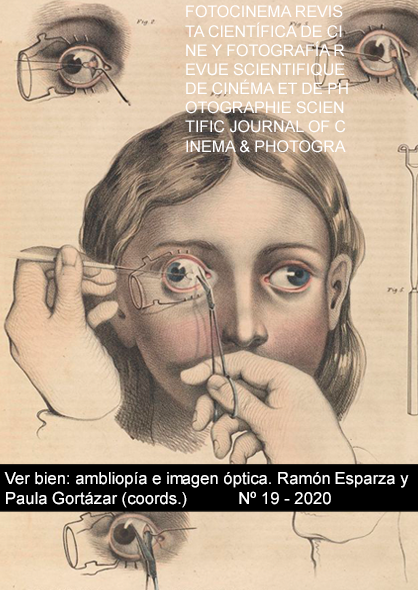Darkness, a photographic strategy in the limit of its essence to represent the urban periphery
DOI:
https://doi.org/10.24310/Fotocinema.2019.v2i19.6650Keywords:
Paradoxes, Night, City, Outskirts, Public Space, Landscape.Abstract
The urban landscape at the change of the century has been the favorite theme of contemporary artistic photography. This focus suggests a personal and public reinvention of common places, and uncovers the essence of these representations.
This paper analyzes photographs of places in the periphery of the city at night. Places which go unnoticed but that have received the detailed observation of the artists. Their attention reveals the complex relationship between both reality and representation in every photograph, as well as reflection and potential political intervention in this reality. To understand the images we used a methodology based on the definition of landscape.
As we go deeper into the images we discover the landscape and the photograph pushing their ontological essence to the limit. This shakes up the foundations of how we think about, represent and occupy these places and these representations.Downloads
Metrics
Publication Facts
Reviewer profiles N/A
Author statements
Indexed in
-
—
- Academic society
- N/A
- Publisher
- Universidad de Málaga
References
Ahrens, C. (2001). Many Many Colored Smarties or The Colors of a One-Dimensional World. En Menzel, K. & Ulm, S. Nightscapes: Fotografien der Nacht.
Augé, M. (1998). Los No Lugares. Espacios del Anonimato. Una Antropología de la Sobremodernidad. Barcelona: Gedisa.
Bachelard, G. (2004). La poética del espacio. Madrid: Fondo de Cultura Económica.
Bauman, Z. (1999). La Globalización: Consecuencias Humanas. Madrid: Fondo de Cultura Económica.
Berger, J. (2006). Ralph Fasanella y la ciudad. Mirar. Barcelona: Gustavo Gili.
Berroeta Torres, H., & Vidal Moranta, T. (2012). La noción de espacio público y la configuración de la ciudad: fundamentos para los relatos de pérdida, civilidad y disputa. Polis. Revista Latinoamericana, (31). https://journals.openedition.org/polis/3612
Borja, J. (2000). Ciudad y ciudadanía. Dos notas. WP núm. 177. Barcelona: Institut de Ciències Polítiques i Socials.
Castells, M. (1998). El espacio de los flujos. La sociedad red en Vol. I de La era de la información: economía, sociedad y cultura. Madrid: Taurus.
Castells, M. (2001). La sociología urbana. Madrid: Alianza Editorial.
Chevrier, J-F. (2007). La fotografía entre las bellas artes y los medios de comunicación. Barcelona: Gustavo Gili.
Esparza, R. (2002). Salamanca, Un Proyecto Fotográfico. Salamanca: Consorcio Salamanca.
Fernández-Cid, M. (2008). Gabriele Basilico. La ciudad está llena de contradicciones que la fotografía separa y aísla. El Cultural, 4 de septiembre.
Francastel, P. (1988). La figura y el lugar. El orden visual del Quattrocento, Barcelona: Laia.
García Márquez, G. (2003). Vivir para contarla. Barcelona: Mondadori.
González-Valerio, B. G. (2018). La fotografía documental y la utopía. Miguel Hernández Communication Journal, (9), pp. 293-307. http://rev.innovacionumh.es/index.php?journal=mhcj&page=article&op=view&path%5B%5D=251
Gorelik, A. (2008). El romance del espacio público. Alteridades, 18 (36), pp. 8-15.
Hall, E. T. (1972) La dimensión oculta. México: Siglo XXI.
Pastor Andrés, G. (2016). Frenético, el espacio-tiempo en la fotografía artística contemporánea. Fotocinema: revista científica de cine y fotografía, (12), pp. 103-129. DOI: http://dx.doi.org/10.24310/Fotocinema.2016.v0i12.6038
Sennett, R. (1994). Carne y piedra. El cuerpo y la ciudad en la civilización occidental. Madrid: Alianza.
Boddy, T. (2004). New Urbanism: ‘The Vancouver Model’ (Speaking of Places). Places, vol. 16, núm. 2, p. 14. En: http://escholarship.org/uc/item/0ns9f0b0 [Consulta: 20/07/2014].
Vidal Moranta, T. y Pol Urrutia, P. (2005). La apropiación del espacio: una propuesta teórica para comprender la vinculación entre las personas y los lugares. Anuario de Psicología. vol. 36, nº 3, pp. 281-297. Barcelona: Facultat de Psicología. Universitat de Barcelona.
Wall, J. (2003). Jeff Wall. Ensayos y entrevistas. Salamanca: Centro de Arte de Salamanca.
Zielony, T. (2005). Post-it city. Ciudades ocasionales. En M. Peran y Barcelona: Centre de Cultura Contamporània de Barcelona, pp. 177-179.
Downloads
Published
How to Cite
Issue
Section
License
All contents published in Fotocinema Revista científica de cine y fotografía are protected under the Creative Commons Attribution-NonCommercial-ShareAlike 4.0 International (CC BY-NC-SA 4.0) license. All about this license is available in the following link: <http://creativecommons.org/licenses/by-nc-sa/4.0>
Users can copy, use, redistribute, share and exhibit publicly as long as:
- The original source and authorship of the material are cited (Journal, Publisher and URL of the work).
- It is not used for comercial purposes.
- The existence of the license and its especifications are mentioned.
There are two sets of authors’ rights: moral and property rights. Moral rights are perpetual prerogatives, unrenounceable, not-transferable, unalienable, imprescriptible and inembargable. According to authors’ rights legislation, Fotocinema. Revista científica de cine y fotografía recognizes and respects authors moral rights, as well as the ownership of property rights, which will be transferred to University of Malaga in open access. The property rights are referred to the benefits that are gained by the use or the dissemination of works. Fotocinema. Revista científica de cine y fotografía is published in an open access form and it is exclusively licenced by any means for doing or authorising distribution, dissemination, reproduction, , adaptation, translation or arrangement of works.
Authors are responsable for obtaining the necessary permission to use copyrighted images.














13.png)



